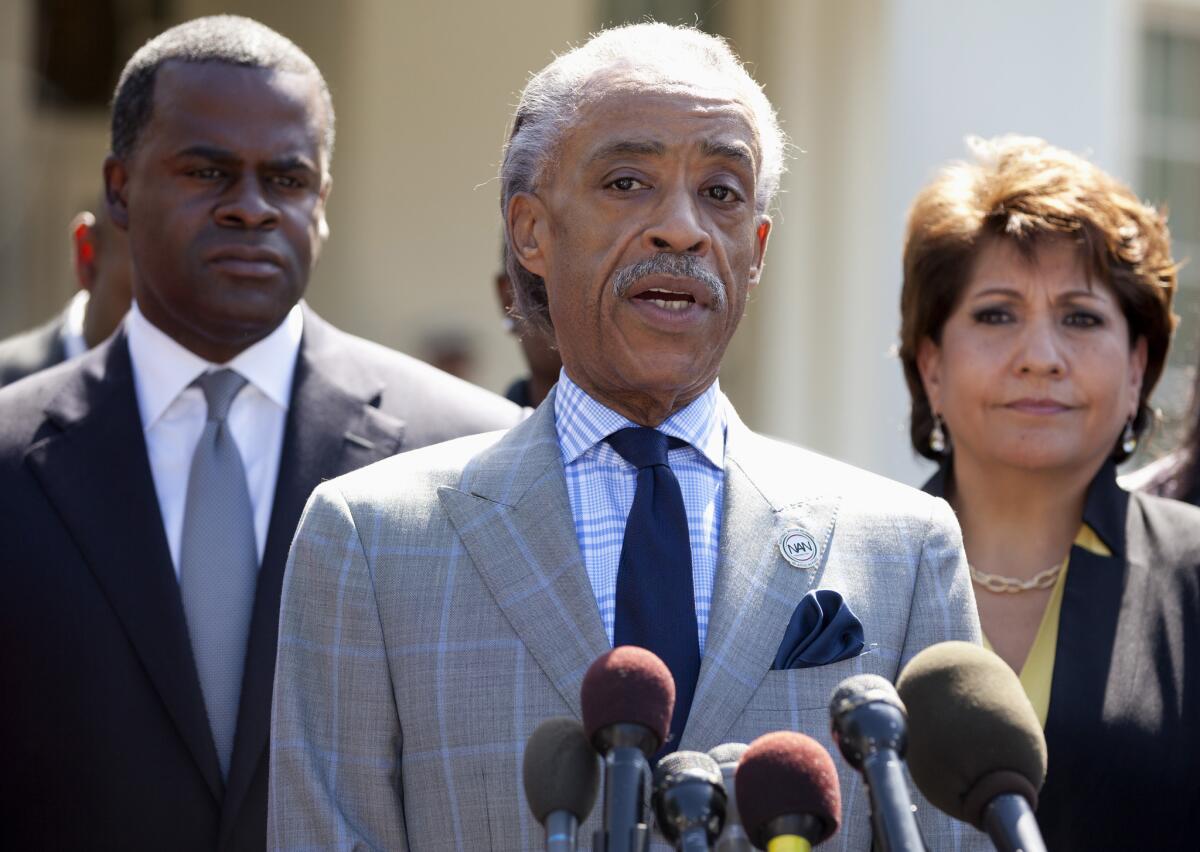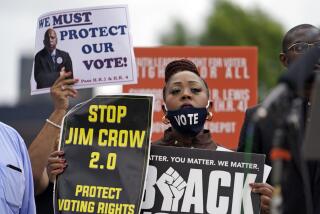The voting rights disaster

It has been less than six weeks since the Supreme Court struck down a key provision of the Voting Rights Act, the landmark law that for five decades has protected this country’s most basic democratic right. But it is already clear that the decision was a disaster.
FOR THE RECORD:
Voting rights: An Aug. 4 editorial said the Voting Rights Act of 1965 was enacted to address overt forms of racial discrimination such as literacy tests and grandfather clauses. Grandfather clauses, which exempted some white voters from literacy tests and poll taxes, were ruled unconstitutional by the Supreme Court 50 years earlier.
Freed of the obligation to seek federal approval before making changes in their election practices, some states have moved to introduce or restore policies that will make it harder for racial minorities to vote or will dilute their political influence. Meanwhile, as any student of contemporary politics could have predicted, a divided Congress shows no sign of moving quickly to adopt a new formula for federal “pre-clearance” of state election changes that would meet the Supreme Court’s requirements.
Although the Voting Rights Act prohibits racial discrimination in voting nationwide, only some states, mostly in the South, had been required to obtain advance approval from the U.S. Department of Justice or a federal judge before they changed their election practices. The problem with that, Chief Justice John G. Roberts Jr. said, was that the formula for deciding which states had to “pre-clear” changes was rooted in data from the 1960s and ‘70s and didn’t reflect “current conditions,” notably dramatic increases in minority turnout in Southern states.
Roberts had a point. When Congress was considering an extension of the pre-clearance system in the early 2000s, it could have started from scratch, scrutinizing evidence of voting discrimination and minority turnout in all 50 states before devising a new formula. Instead, Congress focused on whether pre-clearance was still necessary in states that were guilty of egregious misconduct at the time the Voting Rights Act was enacted in 1965. It concluded that pre-clearance had been highly successful in blocking or forestalling discriminatory actions.
Extending the old coverage formula made it easier for representatives and senators, including those from the South, to support reauthorization of pre-clearance. In that sense, the decision to retain the formula was a political one, but it was also well within Congress’ authority under the Constitution to enforce the 14th and 15th Amendments, which guarantee equal protection of the laws and prohibit racial discrimination in voting. The court was wrong to substitute its judgment for that of Congress. And Roberts demonstrated naivete at best in blithely suggesting that Congress could easily revise the pre-clearance requirement to reflect “current conditions.”
To its credit, the Obama Justice Department is now pursuing an ingenious strategy in an effort to re-establish pre-clearance under an obscure section of the Voting Rights Act not affected by the court’s decision. That section allows federal judges to “bail in” a state for pre-clearance if it is found to have passed voting laws that are intentionally discriminatory. Invoking that section of the law, Atty. Gen. Eric H. Holder Jr. has joined in a challenge to a Texas redistricting map that critics say discriminates against Latino voters. If that strategy proves successful, Texas — and potentially other states — would have to seek advance federal approval of other changes, including requirements that voters produce photo IDs at polling places. (Only hours after the Supreme Court’s decision, Texas officials announced that they would enforce a strict photo ID requirement that been blocked by a court.) One problem with the “bail in” strategy is that while other parts of the Voting Rights Act prohibit practices that have a discriminatory effect, states can be bailed in to pre-clearance only if they have been guilty of racial discrimination by intent.
Even as he announced the new strategy, Holder acknowledged that it was “no substitute for legislation that will fill the void left by the Supreme Court’s decision.” It’s not clear that Congress could rise above partisan and regional divisions to approve a new formula for determining which states must seek pre-clearance of election changes. Republicans are likely to be averse to re-establishing pre-clearance for the same reason they have been enthusiastic about photo ID requirements: Minorities tend to vote Democratic. Indeed, GOP support for a variety of measures that reduce minority turnout may be motivated less by racism than by a quest for partisan advantage. But that doesn’t make them any less odious.
It might seem quixotic, but supporters of voting rights should continue to press both parties in Congress to revisit the Voting Rights Act in light of the high court’s decision. It is worth exploring whether the notion of “covered” states should give way to a nationwide system requiring pre-clearance whenever a court is convinced a state has adopted laws or procedures that have the effect of discriminating against minorities.
Finally, Congress might want to specifically address the issue of photo ID. There is ample evidence that such identification requirements disproportionately inconvenience not only racial minorities but poor, elderly and younger voters as well. On the other hand, photo ID requirements are popular not only in previously “covered” states but throughout the country, and the Supreme Court in 2008 upheld an Indiana photo ID law against a constitutional challenge. It would be consistent with Congress’ responsibility under the 14th and 15th Amendments to enact legislation requiring states that insist on photo IDs to make them free and easy to obtain.
Although it was originally enacted to address overt forms of racial discrimination such as literacy tests and grandfather clauses, the Voting Rights Act and its pre-clearance provisions also have prevented states from engaging in subtler forms of discrimination such as the drawing of district lines that prevent minority voters from electing representatives of their choice. The result has been the increase in minority political participation that (ironically) the Supreme Court cited in striking down the law’s coverage formula. Congress must not allow that progress to be reversed.
More to Read
A cure for the common opinion
Get thought-provoking perspectives with our weekly newsletter.
You may occasionally receive promotional content from the Los Angeles Times.










